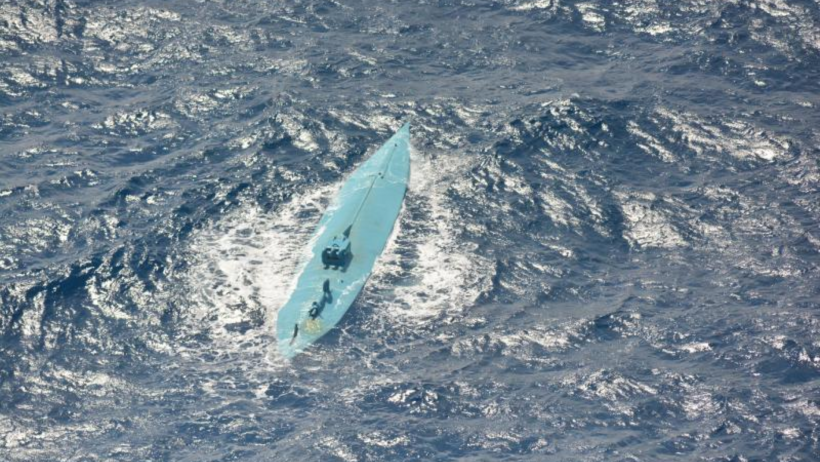
Military intercepted a self-propelled semi-submersible vessel loaded with more than 3,800 pounds of cocaine right outside U.S. borders. (U.S. Customs and Border Protection)
redo Jump to...
print Print...
(by Mary Bowerman, USA Today) – A U.S. Coast Guard cutter intercepted a semi-submersible vessel* filled with thousands of pounds of cocaine off the coast of Texas last month, according to an official statement. [*Self-propelled semi-submersible vessels are low profile vessels designed to navigate low in the water to avoid detection.]
On Nov. 12, the U.S. Customs and Border Protection (CBP) and Air Marine Operations (AMO) along with other agencies including the Coast Guard and the US Navy tracked the self-propelled semi-submersible vessel through international waters, according to a CBP statement.
A day later, a Coast Guard vessel intercepted the drug smugglers, arrested the three-member crew and seized 3,800 pounds of cocaine. The three suspects will face charges in the U.S.
Marine Operations have aircraft that operate from Corpus Christi, Texas, and Jacksonville, Fla., according to the CBP statement. They patrol the borders in transit zones in Central and South America and the aircrews can often detect and disrupt drug smugglers before they reach the U.S. borders, according to the statement.
Allen Durham, the National Air Security Operations Center Corpus Christi Director, said in a statement that drug cartels are “relentless and extremely innovative.”
“Interdicting self-propelled semi-submersible vessels requires expertise and the right aircraft,” Durham said. “Air and Marine Operations will continue to beat the cartels at their own game to protect our borders.”
From USA Today. (With FoxNews and UK Daily Mail). Reprinted here for educational purposes only. May not be reproduced on other websites without permission from USA Today.
Questions
1. The first paragraph of a news article should answer the questions who, what, where and when. List the who, what, where and when of this news item. (NOTE: The remainder of a news article provides details on the why and/or how.)
2. Which government agencies tracked and then intercepted the vessel?
3. a) What is the role of AMO?
b) Where do Marine Operations station the aircraft that participated in the mission?
c) What do the crews of these aircraft do?
4. a) What is a drug cartel?
b) How did Allen Durham of the National Air Security Operations Center describe the drug cartels’ attempts to smuggle drugs into the U.S.?
5. What assurance did Mr. Durham give?
6. How would you describe the work of our U.S. Coast Guard, CBP, Marine Ops, etc. in searching for drug smugglers? (challenging, impossible, inspiring, skillful, etc. …) Explain your answer.
Background
What is the role of U.S. Customs and Border Protection (CPB)?
- U.S. Customs and Border Protection (CBP) is the largest federal law enforcement agency of the U.S. Department of Homeland Security.
- Its primary mission is to safeguard America’s borders thereby protecting the public from dangerous people and materials while enhancing the Nation’s global economic competitiveness by enabling legitimate trade and travel.
- It is charged with regulating and facilitating international trade, collecting import duties, and enforcing U.S. regulations, including trade, customs, and immigration. CBP is one of the largest law enforcement agencies in the United States. It has a workforce of more than 45,600 sworn federal agents and officers. It has its headquarters in Washington, D.C. (from wikipedia)
What is Air and Marine Operations (AMO)?
- Air and Marine Operations (AMO) is a federal law enforcement agency within U.S. Customs and Border Protection (CBP), a component of the Department of Homeland Security (DHS).
- AMO is the world’s largest civilian aviation and maritime law enforcement organization.
- Its mission is to protect the American people and nation’s critical infrastructure through the coordinated use of air and marine assets to detect, interdict and prevent acts of terrorism and the unlawful movement of people, illegal drugs, and other contraband toward or across the borders of the United States. (from wikipedia)
Air and Marine Operations Operating Locations
- U.S. Customs and Border Protection (CBP) views the border as a continuum of activities where the physical border is the last line of defense, not the first. Consequently, CBP’s strategies address the threats and challenges along the continuum.
- The border is not merely a physical frontier. Effectively securing it requires attention to processes that begin outside U.S. borders, occur at the border and continue to all interior regions of the U.S.
- Each of the nation’s border regions provides a nexus point where three transnational threats converge: drug trafficking operations, alien and contraband smugglers and terrorist groups. (from the U.S. Customs and Border Protection website)
Resources
Visit the CPB twitter page
Watch a news report:
Infrared video shows Coast Guard vessels catch ‘narco’ submarine attempting to smuggle more than three tons of cocaine worth millions of dollars into the U.S.:
Daily “Answers” emails are provided for Daily News Articles, Tuesday’s World Events and Friday’s News Quiz.



